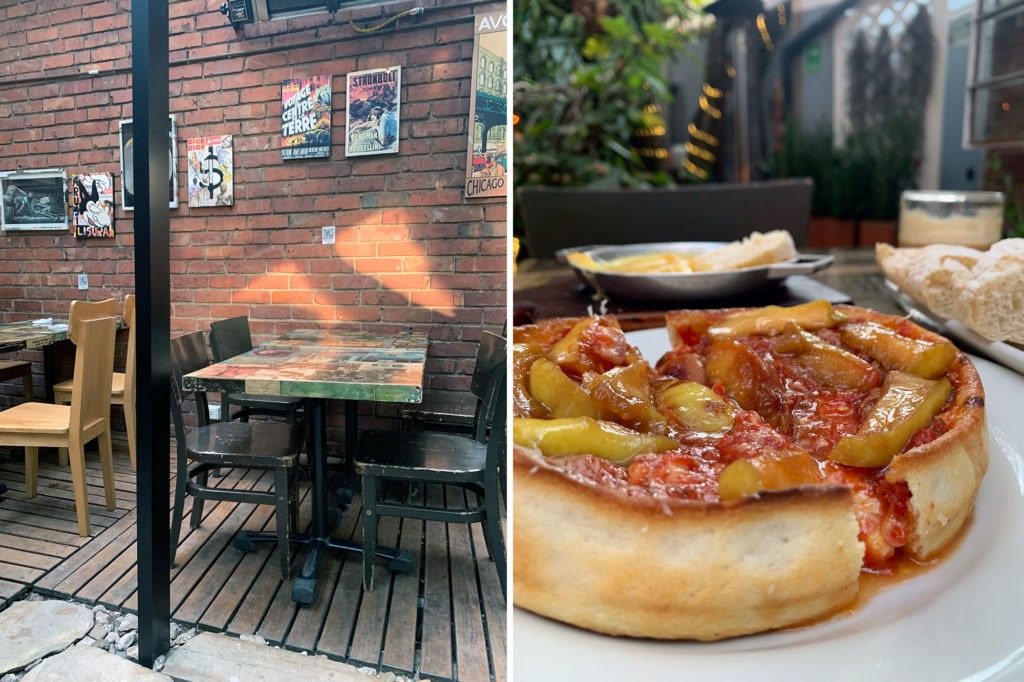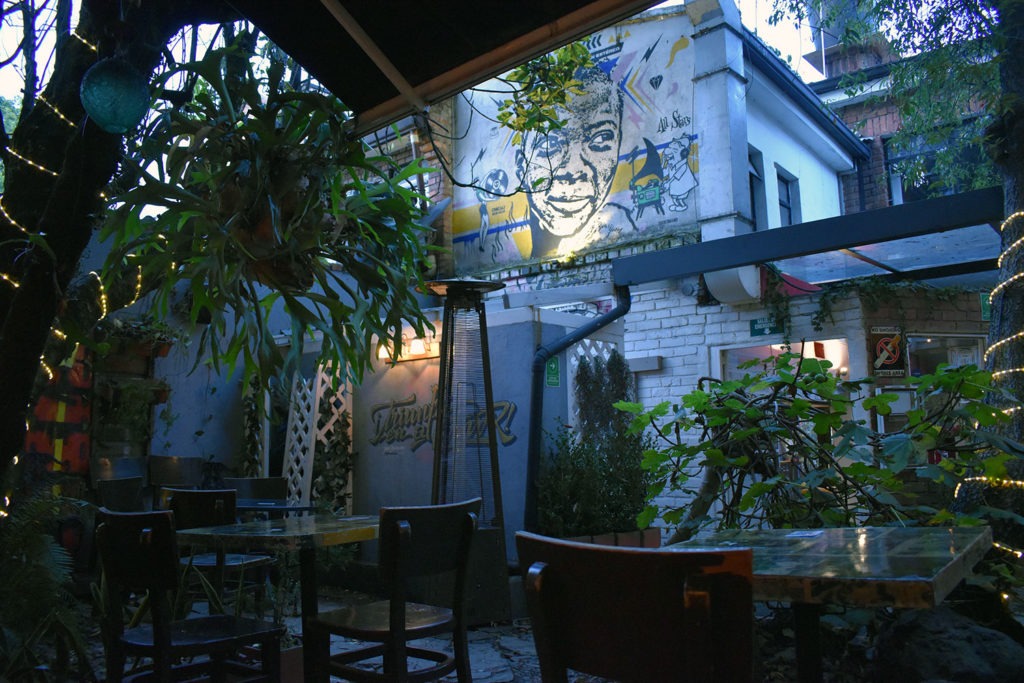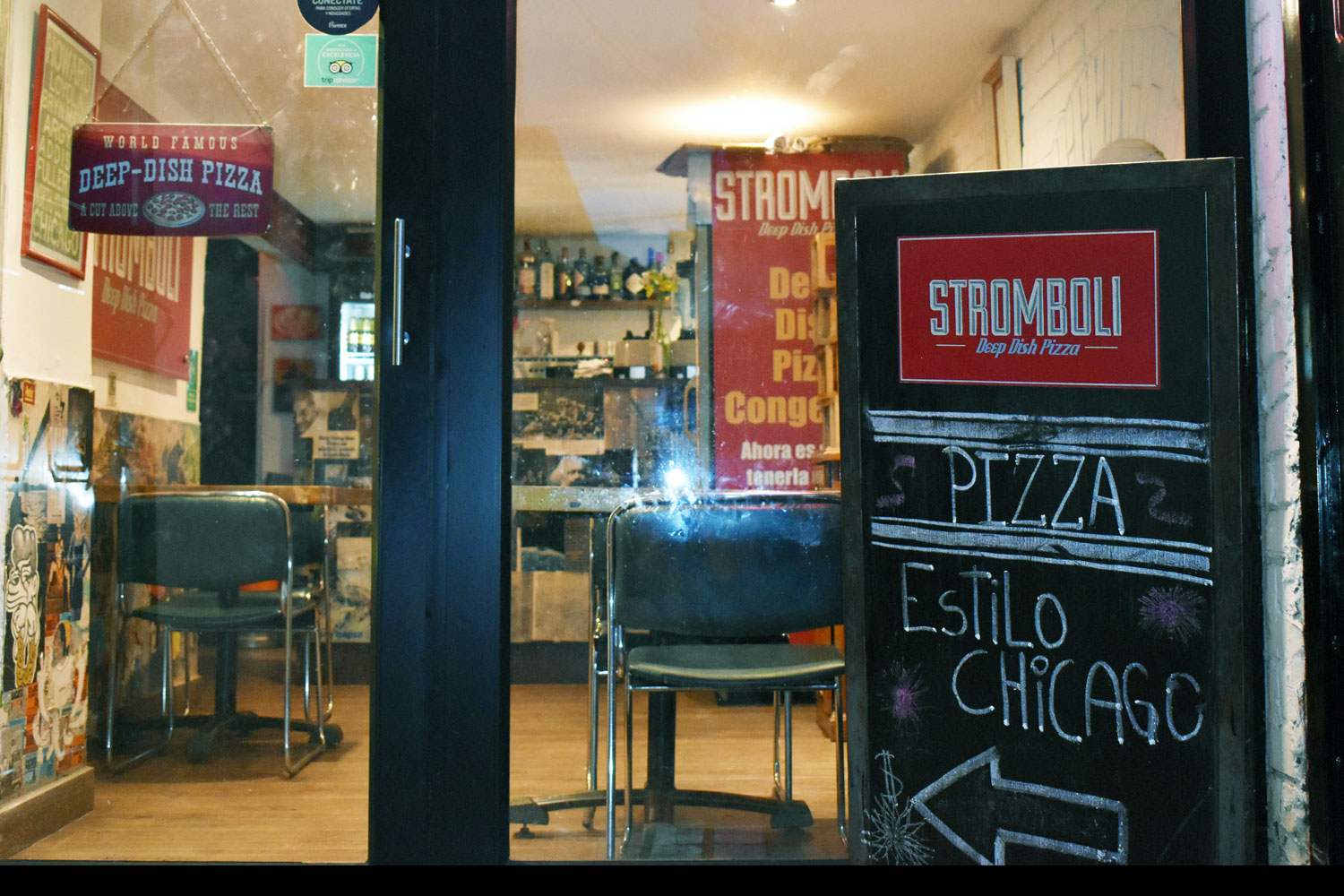For a brief, savory moment, it’s easy to confuse Bogotá, Colombia, with Chicago. But if you happen upon the pocket-sized Quinta Camacho neighborhood tucked into the Chapinero district, you’ll find a taste of the Windy City like no other at Stromboli.
With only 24 hours in Bogotá, I was a man on a mission: discover if Stromboli truly offered a Chicago-style deep dish pizza — or if it was another failed facsimile.
The restaurant’s sign was hardly visible from the street, modestly painted above a small glass storefront and tucked at the end of a narrow alleyway. From the pintsized exterior, it seemed more like a garage converted into a counter service cafe rather than a sit-down pizza joint. Inside, however, the small shop opened up into a cozy courtyard lit by string lights and a square patch of sky peering down on tables spaced just far enough apart to afford an intimate setting.
Jazz and salsa music filled the air as the daylight began to fade. The English translation on the digital drink menu was helpful but unnecessary; the lone word “espresso” was enough to convince me to order the Baileys-Smirnoff mixture known as the Brias de Chicago. The food menu, however, I wouldn’t dare peruse without a little professional insight.
“Queso paipa asado,” the waiter said without a beat. “It’s a mature Colombian cheese grilled and drizzled with lulu and ginger syrup.”
Sold.
“For the pizza, do you like apples?”
Apples…on a pizza? Surely, either his translation was incorrect or the Brias was already doing a number on my auditory nerves.
“Tocineta ahumada y manzana de agua,” he explained. “We make the pizza with caramelized Colombian water apples and bacon. Our pork isn’t too savory and the apples aren’t too sweet, so they go well together.”
Effectively, the Bogotá version of a Hawaiian pizza.
By the time the deep dish pie was set on my two-top, I’d already devoured the piping hot paipa cheese in between sips of the coffee-scented Brias. The sight of the pizza was as intoxicating as the drink: chunks of caramelized apples sunk into the red sauce, resigned to their place above a gooey mixture of mozzarella and Paipa. The crust was far from cardboard, the crispiness on top softened as it rounded the base. Delicate in presentation and robust in flavor, each bite held a flavor of something new with a lingering taste reminiscent of the classic deep-dish pies I’d come to know.
But how did a Chicagoan staple of such quality make it all the way to Bogotá? And why?

Chef Juan Cracks the Code (and Crust)
“I spent 10 days eating nothing but pizza in Chicago,” Chef Juan Camacho said.
A Cali-born chef who moved to Bogotá 20 years ago, Camacho had no intention of starting up a pizza shop when he opened Bogotá’s first bagel joint. His future business partner was studying in the U.S. years prior when he had his first taste of deep dish pizza; he insisted that Camacho bring the dish to Bogotá.
“I had to understand why this pizza was different,” he said. “I tried to research the history of the pizza but decided that the best thing I could do was travel to Chicago.”
The first element of deep dish pizza he knew he needed to perfect was the dough, though no Chicago chef would spill the beans on any of the ingredients aside from “Chicago water.”
“I bought a frozen pizza kit from one of the parlors,” Camacho said with a half-smile. “My father-in-law is a chemist in Barcelona. I deconstructed the dough, dried it into a powder, then sent it to him to analyze in his lab to identify the ingredients and their proportions. From there, it was just a matter of putting it all together to obtain the right texture.”
It took Camacho three months to develop a texture that was similar to the crust in Chicago. With a canvas to build on, Camacho had to devise a way to incorporate local ingredients while relying on the keystone properties of the Chicago-style deep dish pizza. He sourced locally as much as possible for ingredients like cheese, meats, and vegetables; he only imports a specific preservative-free Italian canned tomato for his sauce.
“I want my pizza to honor the tradition but serve up with our heritage,” he said. “I had to make my own version, my own interpretation of what Chicago pizza is, but still respect the physical ingredients. The dough and the sauce are the essence of this pizza.”
When it came to building out the menu, Camacho refused to do a copy-and-paste job. With Bogotá’s growing dining scene encouraging a foodie-like culture, Camacho wanted to offer plates that fed open-minded patrons.
“It would feel wrong if I copied an exact pizza,” he said. “You have to create based on your own style. If you don’t have your personality in your food, you have nothing.”

A Taste of Chicago Within Colombia’s Culinary Community
Stromboli’s pizza transported me 15 years into the past. Every saucy bite stirred up memories of my first deep dish slice at Giordano’s: a mixture of familiarity and fascination baked into an edible moment of happiness. I was a seventeen-year-old who walked into the Windy City as a picky eater and left days later with a new “open-mind, open-mouth” philosophy.
Though Chef Camacho has no plans of putting a Stromboli on every street corner, he does want to elevate the brand by offering frozen pizzas to cook at home, as well as opening a quick-serve concept that maximizes diner convenience without compromising quality.
Until then, he invites Chicago natives to visit him in Bogotá and discover the music, food, and genuine kindness that will make them feel right at home.
“I hope they are proud that Chicago pizza is interesting enough for people outside of the city and the U.S., and that they think it’s nice that someone all the way in Colombia took the time to bring it down to Bogotá.”



